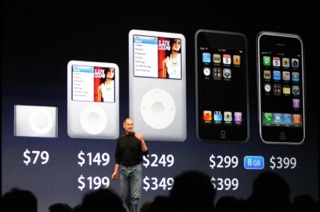 What has made Apple’s iPod so difficult for competitors to beat over the past few years is vision and product planning. Today we saw both in action as Apple completely revamped its market-leading line of music and video entertainment devices, just in time for the 2007 holiday.
What has made Apple’s iPod so difficult for competitors to beat over the past few years is vision and product planning. Today we saw both in action as Apple completely revamped its market-leading line of music and video entertainment devices, just in time for the 2007 holiday.
From the beginning Apple has carefully orchestrated the iPod’s ecosystem, evolving the hardware, software, and online presence carefully as technology has improved and consumers have gotten more comfortable living a digital lifestyle. It’s almost as if the past five years has led to this moment — Apple’s most evolved iPod ecosystem to date.
At “The Beat Goes On” event in San Francisco, Apple’s Steve Jobs presented a clearly-defined line of iPods, including the new iPod Touch, and introduced capability that iPod owners have been clamoring for — the ability to download music from the Internet directly into their devices. This is now possible on the iPod Touch and the iPhone through the new iTunes Wi-Fi Music Store.
Apple’s iPod line now looks like this:
- The iPod Shuffle: music only, for those who are highly active
- The iPod Nano: music, photos and now video, for those who are mobile and want a small, highly styled iPod
- The iPod Classic: music, photos and video, for those who want storage space to carry their libraries with them
- The iPod Touch: music, photos, video, and Internet-capability, for those who want a larger display, a multi-touch interface, and the ability to surf the Web and download music
- The iPhone: music, photos, video, Internet-capability, camera, email, phone, for those who want it all
To set the stage for what was to come at “The Beat Goes On” event, Jobs reminded us of the iPod’s digital music system success. There are more than 600 million copies of iTunes in use on the Mac and PC platforms. Three billion songs have been sold through the iTunes Music Store, along with 95 million TV shows; there are now 550 TV shows available, 125,000 podcasts, including 25,000 video podcasts. The iTMS is the No. 3 music retailer worldwide, behind Wal-Mart and Best Buy.
Jobs then noted that a total of 110 million iPods have been sold worldwide, and each one would be revamped in time for the upcoming holiday season, Apple’s busiest time of year for iPod sales.
iPod Shuffle
Not much happened to the iPod Shuffle. It remains $79, has 1 GB of memory, but it does come in new colors, including (product) Red. For many people, the iPod Shuffle, with its limited interface and storage, is a second iPod.
iPod Nano
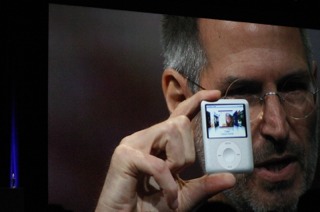 The Nano has gotten fat.
The Nano has gotten fat.
Apple’s best-selling iPod of all time has added some girth to accommodate its new video-playing features, which Jobs said Nano owners wanted. To deliver video, the Nano had to get a little wider to fit a 2-inch diagonal screen and 320 by 240 resolution.
The Nano features an enhanced user interface, bringing Cover Flow to music and videos, and an all-metal design. It features three games, including Sodoku, which are the first free games on an iPod.
The 4 GB Nano comes in silver ($149), and the 8 GB model ($199) comes in black, (product) red, blue, and green. It has 24 hours of audio playback, 5 hours of video. It ships today and is expected to be in Apple Stores this weekend.
The Nano allows people to carry their video, music, and photos with them in the smallest package possible.
iPod Classic
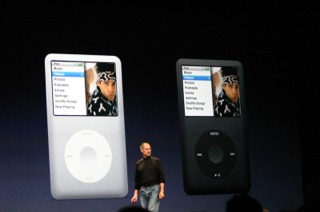 Yes, the iPod is now Classic.
Yes, the iPod is now Classic.
To make room for the iPod Touch, Apple had to do something to differentiate its iPods. The Nano is small. The iPod Touch features the largest display and multi-touch interface. So the Classic is all about storage and the ability to take entire libraries on the go.
Like the Nano, the Classic features the enhanced UI, and sports an all-metal design and is slightly thinner than previous models. The entry-level iPod is now 80 GB ($249). The upper-end iPod ($349) is a whopping 160 GB — a long way from its humble 5 GB beginning.
iPod Touch
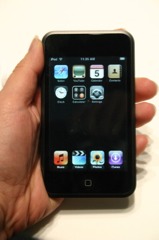 The iPod Touch sacrifices disk space for the display, multi-touch interface and Wi-Fi.
The iPod Touch sacrifices disk space for the display, multi-touch interface and Wi-Fi.
The entry-level Touch is available in 8 GB ($299) and 16 GB ($399) models, which sport the same 3.5-inch, crisp display found on the iPhone. Music, video, and photo icons align the bottom of the Touch’s screen, providing easy access.
The iPod Touch is basically an iPhone without the phone and email. It uses icons similar to the iPhone’s on its “home screen”, allowing users to quickly access Safari, YouTube, calendar, contacts, clock, calculator, and settings.
Best of all, the iPod Touch is Wi-Fi enabled (supporting 802.11 b and g networks), meaning people can access the Web via the Safari browser. iPhone-optimized sites such as Facebook and Web-based chat via Meebo are also available.
Missing from the iPod Touch are the advanced, or “smart phone” features that move it from an entertainment device to an entertainment/communication gadget like the iPhone. Missing on the iPod Touch is the 2-megapixel camera, the support for stocks, Google Maps, and weather, and the Notes capability.
The iPod Touch will be available by the end of September.
iTunes Wi-Fi Music Store
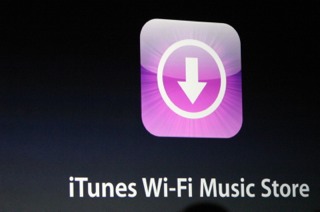 One of the biggest complaints from iPod and iPhone users is that they cannot download songs directly from the iTMS. Direct downloading is something that Apple’s competitors, particularly Microsoft and its Zune, have been pushing. Now with the iTunes Wi-Fi Music Store iTWFMS), people can download purchases directly to the iPod Touch. The next time they dock the Touch to a computer, purchases are automatically synched with iTunes.
One of the biggest complaints from iPod and iPhone users is that they cannot download songs directly from the iTMS. Direct downloading is something that Apple’s competitors, particularly Microsoft and its Zune, have been pushing. Now with the iTunes Wi-Fi Music Store iTWFMS), people can download purchases directly to the iPod Touch. The next time they dock the Touch to a computer, purchases are automatically synched with iTunes.
When at the iTMS, four buttons will be available: Features, Top Ten, Search, and Downloads. People can preview each song, just like they can on the iTMS, and if they like a selection they can tap the Buy Now button to download. No word if one can download videos or subscribe to podcasts and video podcasts.
The iTWFMS will be available in all 22 countries that Apple operates in; the pricing and selection will remain the same. It also will be available for iPhone users through a software update later in the month.
Starbucks Partnership
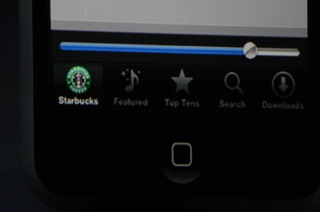 Apple also announced a partnership with coffee emporium Starbucks, making it possible for iPod Touch and iPhone users to download the songs playing in a Starbucks. When people visit the iTWFMS in Starbucks, a button appears that allows them to purchase the song being played, or any of the previous 10 songs played in the store. They do not have to login to the T-Mobile Wi-Fi network that Starbucks uses; access is free for Touch, iPhone, and Mac and PC users.
Apple also announced a partnership with coffee emporium Starbucks, making it possible for iPod Touch and iPhone users to download the songs playing in a Starbucks. When people visit the iTWFMS in Starbucks, a button appears that allows them to purchase the song being played, or any of the previous 10 songs played in the store. They do not have to login to the T-Mobile Wi-Fi network that Starbucks uses; access is free for Touch, iPhone, and Mac and PC users.
Don’t expect the Apple-Starbucks partnership to do much just yet. The new capability will take a substantial infrastructure upgrade that Starbucks will begin with in Seattle and New York, with San Francisco, Los Angeles, and Chicago following. Most major metro-area stores will be upgraded by the end of 2008, with the rest of Starbucks stores to be completed in 2009.
An iPhone Price Break
Jobs ended his presentation by announcing that Apple is discontinuing the 4 GB iPhone due to lack of customer demand. Apple is also dropping the price of the 8 GB iPhone from $599 to $399, a move designed to sell as many iPhones as possible during the holiday season. Jobs said Apple will sell its one millionth iPhone by the end of the month.
Ringtones
To support all of the iPods and iPhone, Apple is releasing a new version of iTunes tonight. It’s biggest feature is ringtone support for the iPhone, which may please some and be a total yawner for others. To buy a song and make a ringtone from the iTMS, the total cost will be $1.98 — 99 cents for the song, 99 cents for the ringtone. To make a previously-purchased song into a ringtone, it will cost 99 cents.
Photo Credit: All images by Kelly Turner, Macworld.
Hands-on images and reviews: Gizmodo, Engadget.
Additional coverage: Macworld.

I just did a post on the new iPods over at Highbrid Nation and I’m pretty excited. I’ve had my current ipod for over two years and its about time for an update.I wonder what other apps we will see for that TOUCH.
Great overview. Apple is at it yet again. The Wi-Fi is the most impressive to me.
HEY i THiNK THAT THiS IPOD iS PRETTY COOL!!!
Wow – what happened? After all than noise its a bit of a surprise that one iPhone already is kicked out and the other one needs a price drop by 200 USD to keep selling !!
Maybe it requires a bit of learning curve that it is possible not enough to stick a full web browser onto a mobile device in order to achieve a GREAT mobile user experience – after all user experience is not only a function of markup, bandwidth: At first its a requirements issue of which is the need of the visitor of your service, which has very strong editorial, navigational, and context aspects that needs to be well supported by a property on the web.
I wonder when people stop thinking that fixed-mobile conversion would end at the wire – it will of course in the same way expand to the other elements of the experience: And kick out the classic desktop device.
It will certainly still take a while before paying mobile users stop accepting to swallow down the bulky, not thought through compromise of an experience that today majority of web sites delivers – even with safari, opera mini and other adaptation technology to reformat to the small screen in place – and instead demand a well designed mobile adapted site that offers a GREAT mobile experience, with all bells and whistles that makes mobile different.
Today if are asked on what the obvious internet experience is that people should expect while mobile, they say: “Duh – of course the full desktop experience!”.
In ten years – when a larger crowd is a bit further down the learning curve, the majority will say “Duh – its mobile targeted OFF COURSE, how could you ignore the ten times greater mobile than desktop internet use?”.
And more and more folks do exactly that: They instead of copying the desktop start to think of what the potential of embracing mobility to the maximum can deliver in value and innovation in services. They will rake in the money and strongly differentiate by delivering services truly adopted to mobile lifestyle – instead of repeating the claim that serving some watered down random compromise derived as result of a auto-reformatting a legacy desktop-targeted content was the best, desirable and demanded mobile experience.
Interesting times to come !!
Should I buy an iPod Touch or wait for the UK release of the iPhone?
The Apple range is getting much better and the designs are as sleek as ever, but they may need to come up with something a little more ground breaking if concepts like the Gphone get released. Could make the iPhone look bad if Google do it right.
Does the Ipod classic have line-in recording capability?